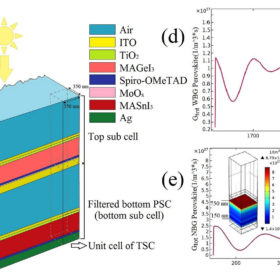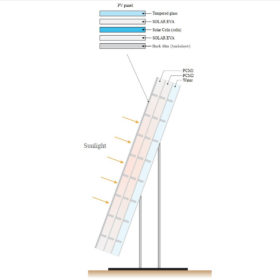Ultra-thin silicon nanoparticle solar cell with 11% efficiency
Iranian scientists have demonstrated a multi-layer silicon nanoparticle (SNP) solar cell based on nanoparticles that are densely stacked inside a dielectric medium. They considered different SNP structures and configurations to tailor these particles as a p–n junction cell.
Iran pre-qualifies 85 bidders for 4 GW solar tender
The Iranian authorities will choose development proposals from domestic and foreign investors for solar projects ranging from 10 MW to 250 MW in size. The selected developers will be awarded 20-year power purchase agreements at a fixed tariff.
Iran launches tender for 4 GW of solar
The Iranian authorities have kicked off a tender to select development proposals for solar projects up to 10 MW in size, from both domestic and foreign investors.
Four-terminal tandem perovskite solar cell design with 30.14% efficiency
The lead-free solar cell was modeled via a three-dimensional finite element method by an Iranian research group. The cell was designed without the buffer layer and with the addition of anti-reflection layer (ARL) strategies, as well as the use of periodic nano-texture patterns.
Carbon-based, HTL-free perovskite solar cells with 26% efficiency
An international research team has designed a carbon-based perovskite solar cell without a hole transport layer. Two plasmonic nanoparticles – Ag@SiO2 and SiO2@Ag@SiO2 – were added to the cell photoactive layer, in addition to a copper(I) thiocyanate (CuSCN) interlayer at the perovskite-carbon interface.
Two-layer phase change materials for solar module cooling
Researchers in Iran have tested four different two-layer PCMs across several cooling system configurations and have found that the payback time of the proposed cooling tech is still far from reaching commercial viability. The system, however, was able to improve PV power generation by more than 3% and produce hot water with a temperature of up to 48 Celsius degrees from the solar module’s excess heat.
Low-cost deposition tech for perovskite solar cells
Italian and Iranian researchers have developed the new “deposition via an antisolvent-soaked applicator” technique, which they describe as an easily scalable process to produce uniform, pinhole-free perovskite films. They tested the process on a 6.7%-efficient solar cell based on a polyethylene terephthalate substrate, raising its power conversion efficiency by 82%.
Iran wants to deploy 10 GW of renewables over the next four years
According to the Iranian authorities, there are currently more than 80GW of renewable energy projects that were submitted by private investors for review.
Iran brings 150MW solar cell factory online
Dec. 23 saw the inauguration of a new solar cell factory in the city of Khomeini, according to the Iranian government’s Renewable Energy and Energy Efficiency Organization. The factory, operated by Tehran headquartered company Mana Energy Pak, will be among the first in the region to produce silicon solar cells.
Hunting the sun with Harris hawks optimization algorithm
An Iranian-Canadian-based research group has conceived a nature-inspired algorithm to estimate the model parameters of PV systems. The proposed tool mimics the exploring, exploiting and attacking strategy of the Harris hawk, a bird of prey species that cooperates when hunting.










